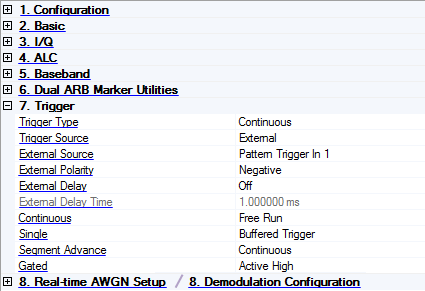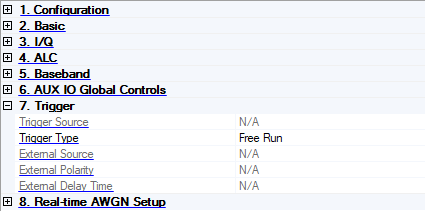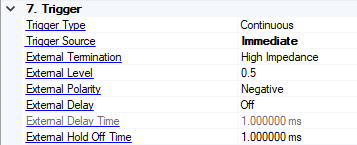7. Trigger
Capability set to Waveform Playback and Phase Compensation set to Auto, Manual, or Off

Capability set to Real-time Uplink or Phase Compensation set to Auto (Real-time) or Manual (Real-time)

M9381A/M9383A

M9383B VXG-m and M9384B VXG

Trigger Type
Choice: Continuous | Single | Gated | Segment Advance
Default: Continuous
Coupling: These selections are available only when Capability is set to Waveform Playback and when Phase Compensation is set to Auto, Manual, or Off.
Double-click or use the drop-down menu to select the triggering mode.
Continuous – selects the continuous triggering mode, which enables the signal generator to repeat the modulating signal indefinitely until you turn off the modulation format, change triggers, or select another waveform.
Single – sets up a waveform to play once after receiving a trigger.
Gated – sets the signal generator to the gated trigger mode, which causes the waveform (modulating signal) to repeatedly start and stop in response to an externally applied trigger signal. To use the gated trigger mode, you must select External as the Trigger Source.
Segment Advance – controls the way the signal generator plays segments within a sequence. This includes determining whether a segment plays once or continuously, and when the sequence advances to the next segment. See Segment Advance.
Trigger Type
(M9383B/M9384B only)
Choice: Continuous | Single
Default: Continuous
Double-click or use the drop-down menu to select the triggering mode.
Continuous – selects the continuous triggering mode, which enables the signal generator to repeat the modulating signal indefinitely until you turn off the modulation format, change triggers, or select another waveform.
Single – sets up a waveform to play once after receiving a trigger.
Trigger Type
Choice: Free Run | Trigger & Run
Coupling: These selections are available only when Capability is set to Real-time Uplink or when Phase Compensation is set to Auto (Real-time) or Manual (Real-time).
Double-click or use the drop-down menu to select the continuous mode and one of the following trigger responses.
Free Run − immediately triggers when you turn the format on.
Trigger & Run − waits for and starts on the first trigger; ignores subsequent triggers.
Trigger Source
Choice: Trigger Key |
External | Bus
Default: External
Coupling: External 2 is available only when Capability is set Real-time Uplink or when Phase Compensation is set to Auto (Real-time) or Manual (Real-time).
Adjusts the trigger source applied to the PATT TRIG IN or AUX I/O connectors.
Trigger Key – selects the front panel hardkey as the trigger source. After making this selection, press the Trigger hardkey to trigger a waveform.
External – enables you to trigger a waveform with an externally supplied trigger signal.
Bus – enables you to trigger a waveform by sending a command through the GPIB, LAN, or AUXILIARY IO (RS-232) input connector.
External 2 – enables you to trigger a waveform with an externally supplied trigger signal.
Trigger Source
(M9383B/M9384B only)
Choice: Trigger Key | External | Bus | Immediate
Default: External
Adjusts the trigger source applied to the PATT TRIG IN or AUX I/O connectors.
Trigger Key − selects the front panel hardkey as the trigger source. After making this selection, press the Trigger hardkey to trigger a waveform.
External − enables you to trigger a waveform with an externally supplied trigger signal.
Immediate − enables immediate triggering of the waveform playing.
Bus − enables you to trigger a waveform by sending a command through the GPIB, LAN, or AUXILIARY IO (RS-232) input connector.
External Termination
(M9383B/M9384B only)
Choice: 50 Ohm | High Impedance
Default: High Impedance
Select the way the trigger line is terminated in the hardware.
External Level
(M9383B/M9384B only)
Range: -3.5 to 3.5
Default: 0.5
Specifies the threshold level in volts at which the trigger transitions states.
External Source
Choice:
Pattern Trigger In 1 | Pattern Trigger In 2
M9381A: TRIG1 | PXI0 | PXI1 | PXI2 | PXI3 | PXI4 | PXI5 | PXI6 | PXI7
Default:
Pattern Trigger In 1
M9381A: PXI0
Selects the rear-panel connector for the external trigger source. This parameter is enabled only if external triggering is selected as the trigger source..
Pattern Trigger In 1 – selects the PATTERN TRIG IN rear-panel BNC connector
Pattern Trigger In 2 – selects the PATTERN TRIG IN 2 (AUXILIARY I/O) rear panel connector
For the M9381A PXIe VSG, double-click or use the drop-down menu to select the front-panel input for the external trigger signal. External must be selected as the trigger source.
TRIG1 – selects the Trig 1 front-panel SMA connector as the external trigger input for the M9381A PXIe VSG
PXI0-PXI7 – selects the backplane bus signal for the M9381A PXIe VSG
External Polarity
Choice: Positive | Negative
Default: Negative
Sets the polarity of the external trigger. This parameter is active only if you select external (Ext) as the trigger source.
Positive – the signal generator triggers an event when it detects a rising edge on the PAT TRIG IN signal.
Negative – the signal generator triggers an event when it detects a falling edge on the PAT TRIG IN signal.
External Delay
Choice: On | Off
Default: Off
Turns the external trigger delay off or on. This parameter is active only after selecting External as the trigger source.
External Delay Time
Range: 5 ns to 41 s
Default: 1 ms
Default (M9383B/M9384B): 0 s
Coupling: These values are available only when Capability is set to Waveform Playback and when Phase Compensation is set to Auto, Manual, or Off.
Sets a delay time between when an external trigger is received and when it is applied to the waveform.
External Delay Time
Range: 0 s to 41 s
Default: 0 s
Coupling: These selections are available only when Capability is set to Real-time Uplink or when Phase Compensation is set to Auto (Real-time) or Manual (Real-time).
Enter a value to set a delay time between when an external trigger is received and when it is applied to the signal.
External Hold Off Time
(M9383B/M9384B only)
Range: 4 ns to 10 s
Default: 1 ms
Sets the amount of time in seconds to hold off until the next trigger.
Continuous
Choice: Free Run | Trigger & Run | Reset & Run
Default: Free Run
Double-click or use the drop-down menu to select the continuous mode and one of the following trigger responses.
Free Run – immediately triggers when you turn the format on.
Trigger & Run – waits for and starts on the first trigger; ignores subsequent triggers.
Reset & Run – waits for and starts on the first trigger; resets and plays on a subsequent trigger.
Trigger Pulse Generation
(M9381A
Choice: On | Off
Default: On
Enable or disable a trigger pulse generation after waveform downloading finished.
Single
Choice: Buffered Trigger | No Retrigger | Restart on Trigger
Default: Buffered Trigger
Double-click or use the drop-down menu to select the single mode and one of the following trigger responses.
No Retrigger – the waveform segment ignores triggers during playback
Buffered Trigger – causes a waveform to accept a trigger during playback and to restart after the current play finishes.
Restart on Trigger – causes a waveform to accept a trigger during playback and to restart immediately after receiving a trigger.
Segment Advance
Choice: Single | Continuous
Default: Continuous
Double-click or use the drop-down menu to select the segment advance mode and one of the following trigger responses.
Single – causes a segment to play once and to wait for a trigger before the sequence advances to the next segment.
Continuous – causes a segment to play continuously until receiving another trigger. Upon receiving the trigger, the sequence advances to the next segment, which then plays continuously.
Gated
Choice: Active High | Active Low
Default: Active High
Double-click or use the drop-down menu to select the gated mode and one of the following trigger responses. To use the gated trigger mode, you must also select External.
Active Low – causes waveform playback to start when the trigger signal goes low and to stop when the trigger signal goes high.
Active High – causes waveform playback to start when the trigger signal goes high and to stop when the trigger signal goes low.